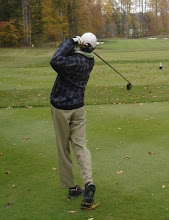It's been a fun season to watch the progress of players on the PGA Tour. There are a couple of players who are playing some amazing golf.
Young players like Bud Cauley seem to have their stuff together. Bud is playing great and in only a few starts is securing his tour card for next year. This is almost unheard of in PGA Tour history.
For as long as I've played golf I've had a favorite player and favorite swing. That is the swing of Moe Norman. Functionally he is the only one that has it right, in my opinion, and everyone else is struggling.
Have you ever wondered why Tiger Woods continues to take instruction? It could be that his swing is not as consistent as it should be.
The "modern" swing still leaves the body in a tough position and open to injury. The legs are asked to do things that they really shouldn't and the joints are stressed on each swing. No wonder there are so many injuries to wrists out there.
One swing that I am fond of that comes close to what Moe did is the swing of Webb Simpson. Webb brings the club back a bit inside and then moves the club with the upper body to and through the ball. The key ingredient to his swing is what he does with the footwork. When you watch his swing you'll notice, like Moe Norman, his feet are basically flat on the ground at impact. That move alone isolates the swing to one axis and allows the player a very consistent pass at the ball.
It's no wonder to me that Webb Simpson leads the Tour in money this year. He has the most consistent swing out there.
Young players like Bud Cauley seem to have their stuff together. Bud is playing great and in only a few starts is securing his tour card for next year. This is almost unheard of in PGA Tour history.
For as long as I've played golf I've had a favorite player and favorite swing. That is the swing of Moe Norman. Functionally he is the only one that has it right, in my opinion, and everyone else is struggling.
Have you ever wondered why Tiger Woods continues to take instruction? It could be that his swing is not as consistent as it should be.
The "modern" swing still leaves the body in a tough position and open to injury. The legs are asked to do things that they really shouldn't and the joints are stressed on each swing. No wonder there are so many injuries to wrists out there.
One swing that I am fond of that comes close to what Moe did is the swing of Webb Simpson. Webb brings the club back a bit inside and then moves the club with the upper body to and through the ball. The key ingredient to his swing is what he does with the footwork. When you watch his swing you'll notice, like Moe Norman, his feet are basically flat on the ground at impact. That move alone isolates the swing to one axis and allows the player a very consistent pass at the ball.
It's no wonder to me that Webb Simpson leads the Tour in money this year. He has the most consistent swing out there.

